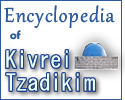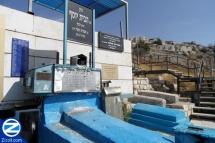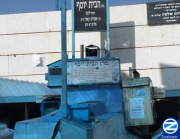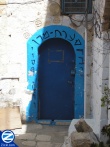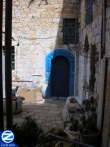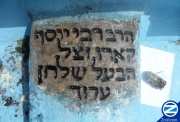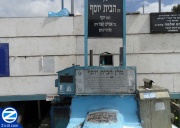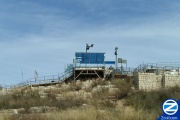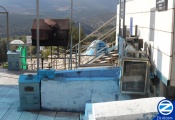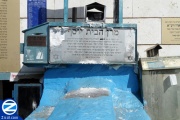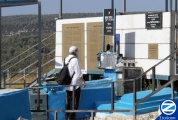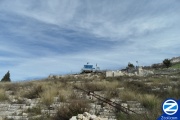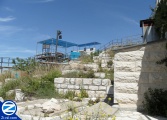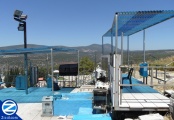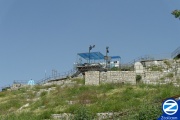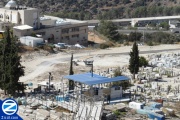Rabbi Yosef Karo
Rabbi Yosef Karo was born in Toledo, Spain. After fleeing the Spanish and Portuguese explosions his family settled in Constantinople. Rabbi Yosef Karo became a renown Torah scholar, serving as a Rav in Adrianople and then Nikopolis. At age 48 he moved to Tzfat, becoming its chief Rabbi after his mentor Rabbi Yackov Beirav left the city. Rabbi Yosef Karo created very important Halachic books including the 'Bais Yosef' an encyclopedic commentary on the Tur, 'Kesef Mishna' on the Rambam and the Shulchan Aruch that became the official Code of Jewish Law. Not especially known as a Kabbalist, Rabbi Yosef Caro wad quite knowledgeable in Kabbalah and was frequently visited by an angelic Maggid who would reveal mysteries of the Torah.
Contents |
[edit] Early Life
[edit] Spanish & Portuguese Expulsions
Yosef Karo was born in Toledo, Spain in 1488 to his parents Rabbi Ephraim ben Yosef and Boyina. In 1492 at age 4, his family relocated to Lisbon, Portugal due to the Spanish Expulsion. Four years later Portugal caved into Spanish pressure and expelled its Jews as well. Once again the Karos had to flee, this time to Turkey.[edit] Cairo
After a long voyage the Karo family reached Cairo, Egypt. Here Yosef studied Torah from his father until he passed away, leaving him a young orphan. His family, left in severe financial strain sacrificed everything so Yosef could continue studying Torah. Yosef Karo joined the Bais Medrash of Rabbi Yackov Beirav, later destined to become his main mentor.
[edit] Constantinople
Yosef's Uncle, Rabbi Yitzchock Caro had reached Constantinople after fleeing Portugal. His entire family had perished due to the suffering on route. Seeing the struggles of his nephew, Rabbi Yitzchok Caro invited Yosef to Constantinople, supporting him financially as he studied. For nineteen years Rabbi Yosef Caro studied Torah in Constantinople while living in worldly seclusion, purifying himself through many fasts and Segufim. During this time he started compiling notes on the Rambam's 'Yad Hachazaka'. These notes later served as the basis for his sefer the 'Bais Yosef'. Despite Constantinople's many Torah scholars, Rabbi Yosef Caro became renown as an extraordinary genius. People started sending him Halacha questions and it was here that he first gained the title 'Moran', an Aramaic term for 'our master'.[edit] Adrianople
At age 30, Rabbi Yosef Caro married his first wife and moved to Adrianople, Turkey to live by his wealth father-in-law Rabbi Chayim Albalag. This marriage did not last long since his wife got sick and passed away. Rabbi Shmuel Saba, a friend of Rabbi Yosef Karo set him up with his sister and he got remarried. In Adrianople, he started composing the 'Bais Yosef', a commentary on the Tur. During his stay in the city, Rabbi Yosef Karo served as head of the local Yeshiva.[edit] Nikopolis
In 1522 Rabbi Yosef Caro moved to Nikopolis, Northern Bulgaria after being appointed Rav and Rosh Yeshiva. Here he spread Torah amongst Yeshiva students who traveled from many countries to study under him. In Nikopolis Rabbi Yosef Caro dedicated a lot of time to writing the 'Bais Yosef.
[edit] Salonica and Constantinople
Due to the lack of reference texts needed to write his book, Rabbi Yosef Caro left Nikopolis in 1533 and travel to libraries in Salonica and Constantinople to gather needed information. During these travels he met the Kabbalist Rebbe Shlomo Alkabetz who influenced him through his Kabalsitic knowledge. Another important meeting that occurred was with Rabbi Shlomo Molcho, a fiery mystic and former Morano scribe in the royal court of Portugal. Rabbi Yosef Caro was very impressed by Rabbi Shlomo Malco and later mentioned him in his writings.[edit] Eretz Yisroel
During the first night of Shavuot 1533, as Rabbi Yosef Karo studied Mishnah along with Rabbi Shlomo Alkabetz, his Maggid revealed himself to them, urging them to immigrate to Eretz Yisroel. In 1536 Rabbi Yosef Karo decided to make the move, first traveling to Adrianople and Nikopolis biding farewell to his former communities. After a trip by sea via Egypt that lasted almost a year, Rabbi Yosef Karo arrived at the city of Safed during the month of Elul. According to some sources, Rabbi Karo once bought a rusty tool that turned out to be filled with gold. Its sale funded the trip to Eretz Yisroel and aided the publication of his books.
[edit] Tzfat
Tzfat was the largest Jewish settlement in Israel at the time, having absorbed many refugees from the Spanish Expulsion, including some leading rabbis. Tzfat's vicinity to the grave of Rebbe Shimon bar Yochi and other spiritual landmarks made it a prime choice for the many Kabalists that settled there. Its central location along trading routes to Egypt, Damascus and Turkey, helped its inhabitants build up a strong economy based on livestock and agriculture. Social welfare and political protection from Dun Yosef Nasi, created a situation where many of Safed's inhabitants could dedicate the majority of their time to Torah study.![]() Read full Zissil article on the Golden Era of Safed
Read full Zissil article on the Golden Era of Safed
Rabbi Yosef Karo received a warm welcome from the scholars of Tzfat which included; Rabbi Yosef Sagus, Rabbi Shlomo Alkabitz, and his former teacher Rabbi Yackov Birav. Upon his arrival he was appointed as a judge in the internationally acclaimed Bais Din of Tzfat.
Shortly afterwords, Rebbe Yosef Caro established a Yeshivah that attracted students from across the world. Since Tzfat did not lack rare manuscripts and reference texts, Rabbi Yosef Caro along with help from Rabbi Yackov Birav, was able to finish composition of the 'Bais Yosef'.
In 1554, Shlomo son of Rabbi Yosef Karo was born, his second wife passing away shortly afterwords. In 1558 the first printing of the 'Bais Yosef' took place in Venice, giving Rabbi Yosef Caro international fame as a Halacha authority. When Rabbi Yackov Birav left Safed after his failed Smicha attempt, Rabbi Yosef Karo was appointed head of the local Bais Din along with Rabbi Moshe of Trani. At the time, the Tzfat Bais Din was the leading Rabbinical Court in Eretz Yisroel and most of Diaspora. Many questions of national and global importance came thorough the Bais Din and Rabbi Yosef Karo's decisions were respected worldwide. In 1565 he married his third wife, the daughter of Rabbi Zicharya Ashkinazi and his son Yehuda was born.[edit] Smicha
In order to give Marranos a chance to atone for sins they committed living as Christians, Rabbi Yackov Beirav attempted to reestablish the Smicha. This would allow the resurrection of the Senhedrin, who could formally give Malkes atoning for sins deserving Kares. According to the Ramabam, all the rabbis in Eretz Yisroel could unite appointing one Rav, giving him the power needed to re-institute the Smicha.
Rabbi Yosef Karo was one of the four students given Smicha by Rabbi Yackov Beirav. After fiery opposition from Rabbi Levi ben Chaviv and the Ridbaz, supporters of the Smicha were forced to back down. Although the reestablishment of the Smicha did not last, Rabbi Yosef Karo passed down the Smicha to his student Rabbi Moshe Alshich, who in turn passed it to Rabbi Chaim Vital. Rabbi Yosef Caro does not mention the Smicha revival throughout any of his books, this could be taken as an acceptance of its failure.
[edit] Repentance for Marranos
Their hopes bashed with the Smicha failure, the Marranos turned to Rebbe Yosef Karo to find an alternative method to rectify their sins. Based on the teachings of the Rambam, he issued a Halachic ruling declaring it unnecessary for the Marranos to undergo Malkes. Instead, the Teshuva they did along the suffering they had undergone was considered sufficient.
[edit] Biriya
In 1566, Rabbi Yosef Caro moved to the nearby settlement of Biriya to avoid constant interruptions to his writing. During his stay in Biriya he started printing his master piece, the 'Shulchan Aruch' in the printing press of R' Avraham Ashkinazi. In recent times a Yeshiva was opened in Birya named after the Bais Yosef.
[edit] Back to Tzfat
Upon recovery from a plague that hit the settlement of Biriya, Rabbi Yosef Caro moved back to Tzfas in 1570. 'Kesef Mishna', his appendix of sources to the Rambam's 'Yad Hachazaka' was published in 1574. Rabbi Yosef Karo supported the building of a mini fortress in Safed to protect its inhabitants. He also issued a ruling that all Torah scholars were free from paying taxes.
[edit] Passing Away
Rabbi Yosef Caro passed away in 1575 on a Thursday, the 13th day of Nisson at the age of 87. He was buried in the ancient cemetery of Safed. On his death bed, Rabbi Yosef Karo was visited by the 'Mabit', who despite their many Halachic disagreements requested that he bless his son.
[edit] Kabbalah
Although Rabbi Yosef Karo is mostly known for his authority in Nigleh, he was also quite knowledgeable in Kabblah. His friends; Rabbi Shlomo Alkabetz and the Arizal were considered the greatest Kabbalists of the era. Rabbi Moshe Cordovero, a prominent Kabbalist was a student of Rabbi Yosef Karo in Nigleh and quotes Kabalistic interpretations from his teacher throughout his books. In the Shulchan Aruch, a number of minhagim are mentioned that are based on the Zohar.
[edit] The Maggid
Many Kabbalists led communications with Magidim and other spiritual beings. Rabbi Yosef Caro is often used as a prime example of such a relationship. A Magid, created by the spiritual energy of his Mishna study would come to him and reveal mysteries of the Torah. Some of these revelations were later recorded in the book 'Maggid Mesharim'. Often the Maggid would rebuke Rabbi Yosef Karo for his laxity in Avodas Hashem that was expected at his level. Occasionally he would reveal future events, although not all of them came into fruition. These prophecies included a description of Rabbi Caro's reward in Gan Edan, his immigration to Eretz Yisroel, publication of his books, his fame spreading throughout the world, having a son who would become a great Torah scholar and meriting to die on Kidush Hashem like Shlomo Malcho.
A few people witnessed these Maggidic revelations. According to their reports, Rabbi Yosef Caro would start reciting Mishnah by heart and suddenly a voice would sound through the door saying "Peace to you Rebbe Yosef Caro, I am the Mishna you studied". Often the Maggid would reveal his teachings in Aramic.
[edit] Association with the Ari
Rabbi Yosef Karo asked the Ari to teach him Kabblah and he refused, informing him that his main task in this world was to study the revealed Torah. As proof, the Ari noted that each time he started revealing mysteries in the presents of Rabbi Yosef Karo, the later would start falling asleep. Rabbi Yosef Karo's son married the Arizal's daughter. A number of times the Ari revealed personal information to him via Rouch Hakodesh.
[edit] Hakafot by the Rashbi
Rabbi Yosef Karo and his students once did Hakafot at the Tzion of Rebbe Shimon and Rebbe Elazar holding their Arba Minim during Sukkot. Soon afterwords a storm started with rain pouring down until nightfall. Although rain on Suckot is considered a bad omen, the Magid revealed to them that this case was different. Since the Arba Minim come to appease for the bringing of water, as soon as they did Hakafos, water was forced to descend. Had they done even one more Hakafa they would have created a mini flood. The Maggid then revealed that doing seven Hakafos around the Kivarim of Rebbe Shimon and his son while fasting is a Segula to bring down rain during years of drought. It is also an efficient Segulah to relieve other forms of suffering.
[edit] Family
Rebbe Yosef descended from the respected Karo family. He got married three times, and had two surviving children, one who married the daughter of the Arizal.
[edit] The Karos
Original founder of the Karo family was Rabbi Shimon Karo, author of the Yalkut Shimoni. His son, Rabbi Yosef was a student of Rashi and is mentioned in the Tosefot. It is known that the Karo's had a genealogy map that traced their family roots way back to the Tana Rabbi Nechunya ben Hakana. Rabbi Nechunya had a son Chanina who was nicknamed 'Kra' due to his ability to read out loud. Overtime the name 'Kra' turned into 'Karo'. Eventually part of the Karo family reached Spain and settled in the city of Toledo.
Rabbi Yosef Karo's grandfather, a wealth merchant, carried the same exact name as his grandson, Rabbi Yosef ben Ephraim. He had two sons Ephraim and Yitzchok whom he raised as Torah scholars.
[edit] Uncle Yitzchok Karo
Rabbi Yitzchok Karo served as Rosh Yeshiva in Lisbon, Portugal. After the Portuguese Expulsion he traveled to Constantinople, his entire family dying on the way due to the hardships and hunger. He was the one that brought Rabbi Yosef Caro to Constantinople and supported him financially as he studied Torah. Rabbi Yitzchok Karo authored a philosophical commentary on the Torah called 'Toldos Yitzchok' published in Constantinople, 1518. His views are mentioned a number of times in the 'Bais Yosef', two responses directed at his questions are included in 'Avkas Rochel' and another one in 'Shalas Utshuvos Bais Yosef'. Towards the end of his life Rabbi Yitzchok Karo moved to Jerusalem.
[edit] Marriages
Rabbi Yosef Karo's first wife was the daughter of Rabbi Chayim Albalag, a wealthy Torah scholar from Adrianople, Turkey. She got sick shortly after the marriage and passed away, without having children.
Rabbi Yosef Karo then married the daughter of Rabbi Yitzchok Saba, sister of his friend Rabbi Shmuel. Shlomo, his son came from this marriage. Shortly after this birth his second wife passed away.
In 1565, at age 77 Rabbi Yosef Caro married his third wife the daughter of Rabbi Zicharya ben Shlomo Zeblish Ashkinazi who bore his second child Yehuda. The Ashkanzi family were involved in the printing industry.
[edit] Children
There are opinions that Rabbi Yosef Karo had a number of children from his early marriages that died in a plague while he still lived in Turkey.
Shlomo was born in Tzfat, 1554 to the second wife of Rabbi Yosef Karo.
Yehuda was born in Tzfat to his third wife. He was three years old when his father passed away. Yehuda published Shalos Uteshuvos Beit Yosef when he grew up.
[edit] Students and Colleagues
Rabbi Yosef Karo's teachers were his father, his uncle Rabbi Yitzchok and Rabbi Yackov Birav.
[edit] Rabbi Shlomo Alkabetz
Rabbi Shlomo Alkabetz author of 'Lecha Dodi' first met Rabbi Yosef Karo during his travels, later they both relocated to Safed. He once took part in a communication session with the Maggid.
[edit] Rebbe Shlomo Malcho
Rebbe Shlomo Malcho grew up as a Marano in Portugal, at a young age becoming a scribe in the royal court. After meeting Dovid Reuvani, he circumcised himself and fled the country. Upon awakening from his circumcision, Rebbe Shlomo Malcho found the gates of Torah open to him and with little effort became very knowledgeable in the Wisdom of Kabbalah. Rabbi Yosef Karo met Rebbe Shlomo Malcho during his travels and was impressed by his Kabalistic knowledge and powers. Rebbe Shlomo Malcho eventually returned to Christian ruled countries and openly declared his beliefs. He was sentenced to death and was burnt at the stake on Kiddush Hashem. Rabbi Yosef Karo greatly envied his death and wished that he too would die for Hashem's glory. Despite numerous promises from his Magid that this would happen, it never came into being.
![]() Read full Zissil article on Rabbi Shlomo Molcho
Read full Zissil article on Rabbi Shlomo Molcho
[edit] The Rama
Rabbi Moshe Isserles exchanged a number of Halachic correspondences with Rabbi Yosef Karo, indicating in some that the latter was greater in the laws of Issur and Heter. Rabbi Moshe Isserles was in-midst of creating on an appendix to the Tur sourcing all its laws called the 'Darchi Moshe', when Rabbi Yosef Karo unknowingly beat him to it by publishing the 'Beit Yosef'. Instead of abandoning his project or publishing a competing book, the Rama shortened his text and turned it into a commentary on the 'Beit Yosef' called the 'Darchi Moshe Hamikutzar'. After the publication of the 'Shulchan Aruch' the Rama created an addition to the work called the 'Mapa', covering the Ashkinazic ruling for each Halacha. Despite their big disagreements in Halacha, the two greatly respected each other. Once Rabbi Yosef Caro sent the Rama an ancient handwritten manuscript of 'Tikkun Sofrim' as a gift.
Once the Rama permitted a certain aguna to remarry, while Rabbi Yosef Karo prohibited it. The Maggid revealed to the Bais Yosef that his ruling was correct. However due to the honor they held for the Rama in heaven, the day he issued his ruling the husband died preventing the woman from sinning.
[edit] The Arizal
Rabbi Yosef Karo had a very active connection with Arizal during the two years he spent in Safed. Although the Arizal refused to teach him Kabblah he took his son Shlomo Karo as a son in law.
[edit] Other Associates
Rabbi Yosef Karo had active connections with the Ridabz - Rabbi Dovid ben Zimra, Rabbi Yosef ben Tzayich, Rabbi Yosef Sagus, Rabbi Moshe Matrani, Rabbi Avraham Tzurfati, Rabbi Shmuel Sabba, Rabbi Yosef ben Lev and Rabbi Yosef Taitazak.
[edit] Students
Rabbi Moshe Cardevero quotes his teacher a number of times throughout his Kabalistic books. Other students include Rabbi Moshe Galante and Rabbi Moshe Alshich who received Semicha from him.
[edit] His Books
[edit] Bais Yosef
The Bais Yosef is an appendix to the Tur providing Talmudic sources for its laws, also quoting omitted rulings from Midrashim, Geonim and Rishonim. It was created at a time of great upheaval in the Jewish world, when a central Halacha guide was very needed. Rabbi Yosef Karo started compiling the Bais Yosef while still in Adrianople. It took 20 years to write and an additional 12 years to edit. Initially the Beit Yosef met opposition from leading Rabbis who voiced concern that it would create laxity amongst Torah scholars who would no longer have to locate and memorize the sources for each Halacha. Eventually this opposition dissolved and the Bais Yosef was accepted worldwide. Later Rabbi Yosef Karo published a condensed version of the Bais Yosef called the Shulchan Aruch that only lists the final Halachic rulings for each law.
![]() Read full Zissil article on the Bais Yosef
Read full Zissil article on the Bais Yosef
[edit] Shulchan Aruch
After publishing the Bais Yosef, Rabbi Yosef Karo summarized all final Halachic rulings and created the Shulchan Aruch. Originally intended as a short Halachaic summery for monthly review, it lost focus once it gained popularity and many commentaries were added. Initially raising opposition, the Shulchan Aruch eventually became the official 'Code of Jewish Law', ending the many differences in the rulings of various Rabanim. Composed of four sections, the Shulchan Aruch deals with all basic aspects of Jewish life. In order to balance the Sefardi biased Halachic rulings, the Rama created an appendix to each law giving the Ashkanazi custom. It is from his work on the Shulchan Aruch that Rabbi Yosef Karo gained the title Ha-Mechaber, literately 'the Author'.
![]() Read full Zissil article on the Shulchan Aruch
Read full Zissil article on the Shulchan Aruch
[edit] Kesef Mishna
Kesef Mishna is a list of sources for the Rambam's Yad Hachazaka. Such a resource was very needed since the Rambam did not supply any sources for his Halachic rulings. Also included are responses to some arguments of the Hasagos HaRavad. In 1573 Rabbi Yosef Karo sent the Kesef Mishana manuscript to a printer in Venice and it was published in 1574. Since its publication, the Kesef Mishna was included in almost every reprint of the Yad Hachazaka.
[edit] Maggid Mesharim
Maggid Mesharim includes many of the kabbalistic revelations and personal messages given to Rabbi Yosef Karo by his Maggid. It is structured according to the Parshas of the Torah and is written mostly in Aramaic. Original notes of these revelations were written by Rabbi Yosef Karo himself, as instructed by his Maggid. Rabbi Yishya Halavi Horowitz (Shela) testified that he saw the original papers with his own eyes and transcribed part of them. Maggid Mesharim was published 70 years after its author passed away, the first part in Lublin, 1646 and the second part in Venice, 1656. Most probably Maggid Mesharim was not created for publication based on its written state. Neither was it mentioned by R' Yehuda Karo when he lists his fathers books in the introduction to Shalos Uteshuvos Beit Yosef.
[edit] Avkas Rochel
Shalous Uteshuvo Avkas Rochel is book of Halachic Responsa dealing with the laws of Aruch Chaim, Yoreh Deah and Choshen Mishpat. Avkas Rochel was first published in Salonika in 1791, over 200 years after Rabbi Yosef Karo passed away. Many of the responses are dated from his stay in Tzfat when Rabbi Yosef Karo headed the local Bais Din. At the time, the Safed Beis Din was very prestigious and Halachic questions were sent there from Rabanim all over the world. A number of the responses deal with the upheaval caused by the aftermath of Spanish and Portuguese expulsions. One of the more famous responses is a ruling that frees Torah scholars from all forms of tax.
[edit] Shalos Uteshuvos Beit Yosef
Shalos Uteshuvos Beit Yosef is a Halachic Responca on laws relating to marriage. Included in the book are two special sections dealing with the laws of Agunos. In his will, Rabbi Yosef Karo commanded his sons to gather his Halachic responsa, compile it into book format and publish it. Yehuda Karo started this project and gathered the responses related to 'Even Haezer', since they were the most organized and error free. Shalos Uteshuvos Beit Yosef was first published by Rabbi Yehuda Karo 23 years after his father passed away (Salonica 1598). It took another two centuries for the remainder of the responses to be published under the name 'Avkas Rochel'.
[edit] Kelalei HaTalmud
Guidelines to Talmudic methodology first published in Salonica in 1598.
[edit] Bedek Habayis
Notes and updates on his earlier work the 'Bais Yosef'. First published in Salonica in 1605, these notes were later incorporated into the Bais Yosef itself.
[edit] Other Works
Rabbi Yosef Karo created commentaries on the Mishna, Rashi and Ramban. Unfortunately these three texts were lost and never published.
A number of speeches labeled as Drashot Harav Yosef Karo on the Torah, Pirkei Avos and Shir Hashirim, were published as part of the collection 'Oz Tzaddikim' in Salonica, 1599.
[edit] Kever Rebbe Yosef Karo
Rabbi Yosef Caro is buried in the ancient cemetery of Safed, half way down between the kever of the Arizal and the new extension at the foot of the mountain. It is accessible through a staircase going down from the Ari, or through two staircases going up from Kever Rebbe Yehosua ben Chananya or the new part of the cemetery in coming from the bottom entrance and Kever Rebbe Pinchos ben Yair. Kever Rebbe Yosef Karo is separated in two, the men's section is in front by the actual Tzion and the women's section in-back behind a wall. The Tzion of Rebbe Yosef Karo includes a Ner Tomid and a small book shelf containing Sefarim. His Kever is visited by the many tourists and spiritual seekers who pass through the cemetery.
[edit] Rebbe Yosef Caro Synagogue
The synagogue is located at the former spot of the Safed Bais Din while it was headed by Rabbi Yosef Karo. Destroyed in the 1837 earthquake, it was rebuilt through the funding of Isaac Guetta. Currently there are Sephardi Shabbot minyonim running in the Shul.
![]() Read full Zissil article on the Rebbe Yosef Caro Shul
Read full Zissil article on the Rebbe Yosef Caro Shul
[edit] House of Rebbe Yosef Karo
The historical home of Rebbe Yosef Karo is in the vicinity of the Yosef Caro Synagogue. It is open at certain times to tourists. During the earthquakes that hit Tzfat, the home of Rebbe Yosef Karo was one of the few houses that did not collapse. Many attributed this to the holiness of its former owner.
[edit] Hillulah of Rabbi Yosef Caro
Hillulah takes place on Yud Gimil Nisson, the day proceeding Erev Peasach. Its vicinity to Peasach lowers the amount of participants but many locals visit the Kever on the Yartzeit of Rabbi Yosef Caro.
[edit] More Photos
- Kever Rabbi Yosef Karo Photo Gallery
| ||||||||||||||

